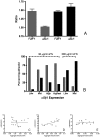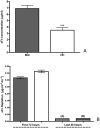Alpha5beta1 integrin-fibronectin interactions specify liquid to solid phase transition of 3D cellular aggregates
- PMID: 20686611
- PMCID: PMC2912296
- DOI: 10.1371/journal.pone.0011830
Alpha5beta1 integrin-fibronectin interactions specify liquid to solid phase transition of 3D cellular aggregates
Abstract
Background: Tissue organization during embryonic development and wound healing depends on the ability of cells on the one hand to exchange adhesive bonds during active rearrangement and on the other to become fixed in place as tissue homeostasis is reached. Cells achieve these contradictory tasks by regulating either cell-cell adhesive bonds, mediated by cadherins, or cell-extracellular matrix (ECM) connections, regulated by integrins. Integrin alpha5beta1 and soluble fibronectin (sFN) are key players in cell-ECM force generation and in ECM polymerization. Here, we explore the interplay between integrin alpha5beta1 and sFN and its influence on tissue mechanical properties and cell sorting behavior.
Methodology/principal findings: We generated a series of cell lines varying in alpha5beta1 receptor density. We then systematically explored the effects of different sFN concentrations on aggregate biomechanical properties using tissue surface tensiometry. We found previously unreported complex behaviors including the observation that interactions between fibronectin and integrin alpha5beta1 generates biphasic tissue cohesion profiles. Specifically, we show that at constant sFn concentration, aggregate cohesion increases linearly as alpha5beta1 receptor density is increased from low to moderate levels, producing a transition from viscoelastic-liquid to pseudo viscoelastic-solid behavior. However, further increase in receptor density causes an abrupt drop in tissue cohesion and a transition back to viscoelastic-liquid properties. We propose that this may be due to depletion of sFn below a critical value in the aggregate microenvironment at high alpha5beta1 levels. We also show that differential expression of alpha5beta1 integrin can promote phase-separation between cells.
Conclusions/significance: The interplay between alpha5-integrin and sFn contributes significantly to tissue cohesion and, depending on their level of expression, can mediate a shift from liquid to elastic behavior. This interplay represents a tunable level of control between integrins and the ECM that can influence tissue cohesion and other mechanical properties, which may translate to the specification of tissue structure and function. These studies provide insights into important biological processes such as embryonic development, wound healing, and for tissue engineering applications.
Conflict of interest statement
Figures








Similar articles
-
Alpha5beta1 integrin mediates strong tissue cohesion.J Cell Sci. 2003 Jan 15;116(Pt 2):377-86. doi: 10.1242/jcs.00231. J Cell Sci. 2003. PMID: 12482923
-
Fibronectin matrix assembly regulates alpha5beta1-mediated cell cohesion.Mol Biol Cell. 2004 Mar;15(3):973-81. doi: 10.1091/mbc.e03-07-0528. Epub 2004 Jan 12. Mol Biol Cell. 2004. PMID: 14718567 Free PMC article.
-
Binding of ZO-1 to α5β1 integrins regulates the mechanical properties of α5β1-fibronectin links.Mol Biol Cell. 2017 Jul 7;28(14):1847-1852. doi: 10.1091/mbc.E17-01-0006. Epub 2017 Mar 1. Mol Biol Cell. 2017. PMID: 28251923 Free PMC article.
-
Modulation of MMPs by cell surface integrin receptor α5β1.Anticancer Agents Med Chem. 2012 Sep;12(7):726-32. doi: 10.2174/187152012802650183. Anticancer Agents Med Chem. 2012. PMID: 22292746 Review.
-
Coordinated regulation of vascular Ca2+ and K+ channels by integrin signaling.Adv Exp Med Biol. 2010;674:69-79. doi: 10.1007/978-1-4419-6066-5_7. Adv Exp Med Biol. 2010. PMID: 20549941 Review.
Cited by
-
Three-dimensional aggregates of mesenchymal stem cells: cellular mechanisms, biological properties, and applications.Tissue Eng Part B Rev. 2014 Oct;20(5):365-80. doi: 10.1089/ten.TEB.2013.0537. Epub 2013 Dec 13. Tissue Eng Part B Rev. 2014. PMID: 24168395 Free PMC article. Review.
-
Anteroposterior Wnt-RA Gradient Defines Adhesion and Migration Properties of Neural Progenitors in Developing Spinal Cord.Stem Cell Reports. 2020 Oct 13;15(4):898-911. doi: 10.1016/j.stemcr.2020.08.016. Epub 2020 Sep 24. Stem Cell Reports. 2020. PMID: 32976767 Free PMC article.
-
Identification of immunoreactive regions of homology between soluble epidermal growth factor receptor and α5-integrin.Biochemistry. 2011 May 24;50(20):4309-21. doi: 10.1021/bi200126j. Epub 2011 Apr 27. Biochemistry. 2011. PMID: 21491912 Free PMC article.
-
Omics Investigations of Prostate Cancer Cells Exposed to Simulated Microgravity Conditions.Biomolecules. 2025 Feb 18;15(2):303. doi: 10.3390/biom15020303. Biomolecules. 2025. PMID: 40001606 Free PMC article.
-
Fibronectin matrix-mediated cohesion suppresses invasion of prostate cancer cells.BMC Cancer. 2012 Mar 20;12:94. doi: 10.1186/1471-2407-12-94. BMC Cancer. 2012. PMID: 22433434 Free PMC article.
References
-
- Steinberg MS. The assembly of embryonic cells into tissues and organs mimics liquid behavior and is guided by interfacial energies arising from cellular adhesive interactions. In: Beysens D, Boccara N, Forgacs G, editors. Dynamical Phenomena at Interfaces, Surfaces and Membranes. Commack, N. Y.: Nova Science Publishers, Inc; 1992. pp. 3–10.
-
- Foty RA, Steinberg MS. The differential adhesion hypothesis: a direct evaluation. Dev Biol. 2005;278:255–263. - PubMed
-
- Robinson EE, Zazzali KM, Corbett SA, Foty RA. Alpha5beta1 integrin mediates strong tissue cohesion. J Cell Sci. 2003;116:377–386. - PubMed
Publication types
MeSH terms
Substances
Grants and funding
LinkOut - more resources
Full Text Sources
Research Materials
Miscellaneous

